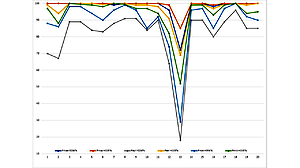Current issue
Archive
Manuscripts accepted
About the Journal
Editorial office
Editorial board
Section Editors
Abstracting and indexing
Subscription
Contact
Ethical standards and procedures
Most read articles
Instructions for authors
Article Processing Charge (APC)
Regulations of paying article processing charge (APC)
ELECTROPHYSIOLOGY / CLINICAL RESEARCH
How often is right-power ablation equal to highpower ablation during pulmonary vein isolation under temperature control? Does the learning curve matter?
1
I Chair and Department of Cardiology, Medical University of Warszaw, Poland
2
Department and Clinic of Emergency Medicine, Wrocław, Poland
Submission date: 2021-12-28
Final revision date: 2022-02-06
Acceptance date: 2022-03-15
Online publication date: 2022-04-04
Corresponding author
Edward Koźluk
I Chair and Department of Cardiology Medical University of Warsaw, Banacha 1A, 02-097 Warszawa, Poland
I Chair and Department of Cardiology Medical University of Warsaw, Banacha 1A, 02-097 Warszawa, Poland
KEYWORDS
atrial fibrillationlearning curvepulmonary vein isolationhigh power ablationtemperature control ablationDiamond Temp catheter
TOPICS
ABSTRACT
Introduction:
The energy applied under temperature control (TC) has a more predictable effect than the one applied under power control. The currently introduced cooled-tip DiamondTemp catheter (DT) restores the ability to adjust radiofrequency (RF) power to the temperature at the electrode-tissue interface. It also enables high-power (HP) ablation procedures. Aim of the study was to assess how often ablation with TC at a 50 W nominal setting meets HP ablation criteria. We analyzed the influence of the learning curve on the results.
Material and methods:
The course of 3350 applications performed using DT in 20 patients (14 M, age 55 ±13 years) with atrial fibrillation/left atrial flutter was analyzed. 24 applications with 1–2 s duration were excluded. Average (Pavg), minimal (Pmin), and maximal (Pmax) power were evaluated. The percentage of applications > 45 and > 50 W (Pmin > 49 W) was assessed.
Results:
From 3326 applications with the duration > 2 s only 1430 (43%) were between 3 and 10 s (excellent catheter/muscle contact). There was an insignificant trend to increase the percentage of short applications during the learning curve (p = 0.054). Pmin > 45, > 49 or > 50 W was recorded during 3130 (94.1%), 2963 (89.1%) and 98 (1.1%) applications, respectively. Pavg 45 or 50 W was recorded during 3230 (97.1%) and 2700 (81.2%) applications, Pmax during 3296 (99.1%) and 3269 (98.3%) applications. The percentage of applications with Pavg and Pmin > 45/> 50 (49) W (but not Pmax) significantly decreased during the procedures in the second subgroup of patients.
Conclusions:
Pmax seems not to be as good a criterion for classification of application as HP. Most TC applications performed with the DT meet the criteria for HP ablation. The learning curve impacts the percentage of HP applications.
The energy applied under temperature control (TC) has a more predictable effect than the one applied under power control. The currently introduced cooled-tip DiamondTemp catheter (DT) restores the ability to adjust radiofrequency (RF) power to the temperature at the electrode-tissue interface. It also enables high-power (HP) ablation procedures. Aim of the study was to assess how often ablation with TC at a 50 W nominal setting meets HP ablation criteria. We analyzed the influence of the learning curve on the results.
Material and methods:
The course of 3350 applications performed using DT in 20 patients (14 M, age 55 ±13 years) with atrial fibrillation/left atrial flutter was analyzed. 24 applications with 1–2 s duration were excluded. Average (Pavg), minimal (Pmin), and maximal (Pmax) power were evaluated. The percentage of applications > 45 and > 50 W (Pmin > 49 W) was assessed.
Results:
From 3326 applications with the duration > 2 s only 1430 (43%) were between 3 and 10 s (excellent catheter/muscle contact). There was an insignificant trend to increase the percentage of short applications during the learning curve (p = 0.054). Pmin > 45, > 49 or > 50 W was recorded during 3130 (94.1%), 2963 (89.1%) and 98 (1.1%) applications, respectively. Pavg 45 or 50 W was recorded during 3230 (97.1%) and 2700 (81.2%) applications, Pmax during 3296 (99.1%) and 3269 (98.3%) applications. The percentage of applications with Pavg and Pmin > 45/> 50 (49) W (but not Pmax) significantly decreased during the procedures in the second subgroup of patients.
Conclusions:
Pmax seems not to be as good a criterion for classification of application as HP. Most TC applications performed with the DT meet the criteria for HP ablation. The learning curve impacts the percentage of HP applications.
Share
RELATED ARTICLE
We process personal data collected when visiting the website. The function of obtaining information about users and their behavior is carried out by voluntarily entered information in forms and saving cookies in end devices. Data, including cookies, are used to provide services, improve the user experience and to analyze the traffic in accordance with the Privacy policy. Data are also collected and processed by Google Analytics tool (more).
You can change cookies settings in your browser. Restricted use of cookies in the browser configuration may affect some functionalities of the website.
You can change cookies settings in your browser. Restricted use of cookies in the browser configuration may affect some functionalities of the website.



